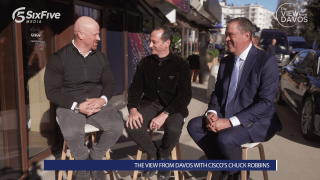The Six Five team discusses Micron Q1FY25 Earnings
If you are interested in watching the full episode you can check it out here.
Disclaimer: The Six Five Webcast is for information and entertainment purposes only. Over the course of this webcast, we may talk about companies that are publicly traded and we may even reference that fact and their equity share price, but please do not take anything that we say as a recommendation about what you should do with your investment dollars. We are not investment advisors and we ask that you do not treat us as such.
Transcript:
Daniel Newman: Micron. I mean everybody was like, “HBM to the moon.” What happened?
Patrick Moorhead: Well, stocks down 18% in a week, so something really horrible must have happened. And net net, they hit revenue, they beat on EPS, and they absolutely had a train wreck for their guide, even though Enterprise, sorry, HBM is actually to the moon. And I think what it shows is you’ve got to have a balanced portfolio of wins here. You can’t just have one win and then have a train wreck everywhere else. I always like to separate this into market driven versus self-inflicted wounds. And I think this is kind of a market driven, given that the PC market, the smartphone market is down, even though the data center number and market, their data center number was up 400% and it’s 50% revenue of the entire company. That’s a combination of HBM and of SSD. So, yeah, people got spooked and we’ve seen this characterization in the market or this reaction in the market when somebody stubs their toe. Two quarters ago, Dell margins on AI servers. We haven’t exactly seen much of anything. Like you said earlier in the show on NVIDIA, I think AMD is down for the year. So we’re having this leveling off.
On the flip side, you’ve got Broadcom, that’s a trillion dollar company based on the back of primarily its XPU. You’ve got Marvell that’s flying here. I think the company, if I have a critique of the company, company needs to talk more. They need to talk more consistently out there and they need to even talk a lot more outside of their earnings. I’ve really seen a ramp down in communications from the company in the last year and I don’t know if that’s, “Hey, we’re going to talk about something when we think we have something great,” but I think when the company doesn’t talk a whole lot out there, I think that people think that the company might be hiding something or there might be bad news and I’d like to see the company doing what it had done maybe the prior two years.
Daniel Newman: Yeah. All right. So, what are we talking about again? No, I’m kidding. So, I had a chance, I joined CNBC Squawk Asia on this one and I did definitely dig into it. You hit some of the really important points, but they went over 50% of their revenue from data center this quarter. That is a massive pivot. Now we’re seeing this playbook a little bit. It’s taking different time cycles, but like Marvell, you talked about Broadcom, but Broadcom made a really hard pivot this year in its business to these AI-based, both networking and XPU chips that has created a lot of value. Marvell made the pivot to AI-driven revenue and data center to get out of sort of its comms and network, some of its traditional core businesses and was able to really overcome it.
Now, the question is for Micron is I think everyone appreciates the HBM market. They understand it. There’s three players; Samsung, SK, and Micron. All three of them are working very fast to try to win this market. And Micron has gotten some validations for NVIDIA, which is really important in terms of growth. But having said that, I mean look, they missed their guide by a billion while still crushing HBM. So this is the bifurcation that a lot of people are struggling with. Everyone’s like, “Oh my God, it’s terrible.” No, it’s not terrible. Literally, Micron is having the same problem that every semi company has had that was outside of pure data center business. And that’s burning off inventory, dealing with pricing pressures, and the fact that the PC, I’m going to say the quiet part out loud here, Pat, the AI PC cycle has been a bust so far. It’s not a bust forever, it’s just a bust so far.
Patrick Moorhead: A total bust, man. I mean you say you’re going to deliver software in June to the general public and you still have not delivered it and it’s December 20th and I’m looking at you, Microsoft, right?
Daniel Newman: Yeah. And it’s fair. And that’s a fair thing. You and I made calls about the… I’ll take my lumps. I made calls that the second half was going to see more acceleration. I saw recent numbers that actually shipments are down on overall on PC numbers. And now you’ve got more silicon diversity, you got more choices, meaning that everyone’s unit volumes are going to take a bit of a hit there. And so what I’m saying is Micron, to have made the pivot it’s made, to be profitable, to do it all on the back of data center while basically their core business, the D-RAM business for PCs and smartphones is bleh, is actually a pretty good pivot. So the AI trade is still intact, but meanwhile the PC and smartphone business has got to get going again. That’s why I kind of look back at my comment about Apple. It’s like, what the heck? They’ve had their new phone, Apple intelligence, this, that, and the other thing, and we’re not seeing unit growth. So why is all this exuberance into Apple while PCs aren’t selling, and at the same time you see with the Micron numbers is it’s all more dependency, Marvell numbers, Broadcom numbers, Micron numbers, all dependency on this AI silicon.
Patrick Moorhead: Maybe Apple is a very safe bet.
Daniel Newman: I think so.
Patrick Moorhead: I’d be super interested to see where the trades come from. I think there’s a lot of money coming overseas to the United States and where are you going to put it that’s safe?
Daniel Newman: I think it’s a… First of all, you look at their buybacks and the amount of money they’ve spent to lower their float count, I think it’s a great bet for investors. I just mean as a whole, it’s not a bet based on innovation. It’s certainly not a bet based on-
Patrick Moorhead: They’re more of like an Apple. Sorry, they’re more like an IBM trade.
Daniel Newman: Yeah, 30 years ago, right?
Patrick Moorhead: No, well, they’re not a growth. I mean IBM is not a growth stock at this point. They’re doing a lot of stuff right, but I’m just saying they’re a safe bet, right? You’re not going to lose your butt on it.
Daniel Newman: Well, and they’ve literally lowered their float in half by buying their own stock back, which is, I mean it’s one of those things like, I mean if you can, why not? I mean it’s not a bad thing.
Patrick Moorhead: Don’t forget the stumbles. I mean they got out of the automotive market. That’s one market they’re out of. They stumbled on Vision Pro, possibly the worst product they’ve ever brought and arguably top five worst products they ever brought out.






















































































